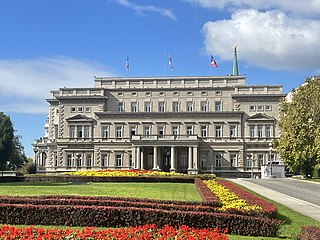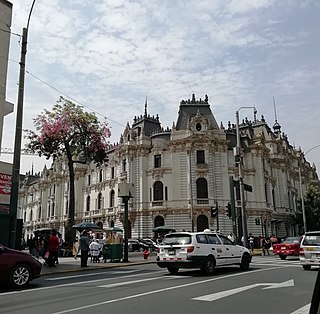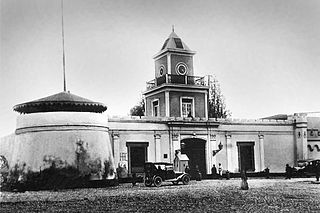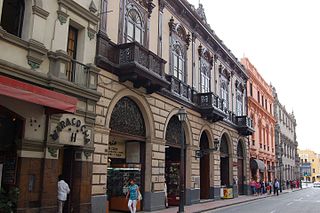
Lima, founded in 1535 as the Ciudad de los Reyes, is the capital and largest city of Peru. It is located in the valleys of the Chillón, Rímac and Lurín Rivers, in the desert zone of the central coastal part of the country, overlooking the Pacific Ocean. The city is considered the political, cultural, financial and commercial center of Peru. Due to its geostrategic importance, the Globalization and World Cities Research Network has categorized it as a "beta" tier city. Jurisdictionally, the metropolis extends mainly within the province of Lima and in a smaller portion, to the west, within the Constitutional Province of Callao, where the seaport and the Jorge Chávez Airport are located. Both provinces have regional autonomy since 2002.

Baroque architecture is a highly decorative and theatrical style which appeared in Italy in the early 17th century and gradually spread across Europe. It was originally introduced by the Catholic Church, particularly by the Jesuits, as a means to combat the Reformation and the Protestant church with a new architecture that inspired surprise and awe. It reached its peak in the High Baroque (1625–1675), when it was used in churches and palaces in Italy, Spain, Portugal, France, Bavaria and Austria. In the Late Baroque period (1675–1750), it reached as far as Russia, the Ottoman Empire and the Spanish and Portuguese colonies in Latin America. In about 1730, an even more elaborately decorative variant called Rococo appeared and flourished in Central Europe.

The monumental complex of the Basilica and Convent of San Francisco of Lima, also known as "San Francisco el Grande" or "San Francisco de Jesús", is located in the Historic Center of Lima, Peru. This church together with the Sanctuary Nuestra Señora de la Soledad and the Church del Milagro set up one of the welcoming and artistic corners of Lima. Ramón Menéndez Pidal, Spanish philologist and scholar in this regard commented: "It is the largest and noblest monument that the conquest erected in these prodigious lands".

The Casa de Osambela, also known as the Casa de Oquendo, is a building built during the colonial era of Peru. It stands on the old Novitiate of the Dominican fathers, destroyed by the earthquake of 1746, and part of the garden, facing the Calle de la Veracruz in the historic center of the city of Lima. It is one of the largest mansions in the center of Lima and is notable for its wide façade and excellent quality balconies.

The Palacio de Torre Tagle is a building built during the colonial era of Peru that currently serves as the main headquarters of the Ministry of Foreign Affairs of Peru. It is located in the Jirón Ucayali in the historic center of Lima, two blocks southeast of the Plaza Mayor de Lima.

The Government Palace, also known as the House of Pizarro, is the seat of the executive branch of the Peruvian government, and the official residence of the president of Peru. The palace is a stately government building, occupying the northern side of the Plaza Mayor in Peru's capital city, Lima. Set on the Rímac River, the palace occupies the site of a very large huaca that incorporated a shrine to Taulichusco, the last kuraka of Lima.

The Basilica Metropolitan Cathedral of Lima and Primate of Peru, otherwise Lima Metropolitan Cathedral, is a Roman Catholic cathedral located in the Plaza Mayor of downtown Lima, Peru. This third and current Cathedral of Lima was built between 1602 and 1797. It is dedicated to St. John, Apostle and Evangelist.

Stari dvor was the royal residence of the Obrenović and later Karađorđević dynasty. Today it houses the City Assembly of Belgrade. The palace is located on the corner of Kralja Milana and Dragoslava Jovanovića streets in Belgrade, Serbia, opposite Novi dvor.

The Jirón de la Unión, or Union Street, is a pedestrian street located in the Historic Centre of Lima, part of the capital of Peru. For many decades it was the most important boulevards of the city, often described as the most aristocratic, where many of the most affluent citizens of the city and most powerful men around the world would meet. Subsequently, with the deterioration of the center of Lima, the Jirón de la Unión lost its aristocratic character and became completely commercialized.

The Plaza Mayor de Lima, or Plaza de Armas de Lima, is considered one of the birthplaces of the city of Lima, as well as the core of the city. Located in the Historic Centre of Lima, it is surrounded by the Government Palace, Lima Metropolitan Cathedral, Archbishop's Palace of Lima, the Municipal Palace, and the Palacio de la Unión.

The Palacio Municipal de Lima or City Hall of Lima is a public building that serves as headquarters of the Metropolitan Municipality of Lima. It is located on the street Portal de Escribanos, block 3 of Jirón de la Unión, and in front of the Plaza Mayor of Lima's historic centre.

The Palace of San Telmo is a historical edifice in Seville, southern Spain, formerly the Universidad de Mareantes, now is the seat of the presidency of the Andalusian Autonomous Government. Construction of the building began in 1682 outside the walls of the city, on property belonging to the Tribunal of the Holy Office, the institution responsible for the Spanish Inquisition. It was originally constructed as the seat of the University of Navigators, a school to educate orphaned children and train them as sailors.
The Historic Centre of Trujillo is the main urban area and the most important center of development and unfolding in the Peruvian city of Trujillo located in La Libertad Region. The whole process of its original urban fabric is in elliptical shape surrounded by España Avenue that was built in the wake of the Wall of Trujillo. It houses the seat of city government and other important entities in the locality. In the center of this historic urban area is the Plaza de Armas of Trujillo that was the scene of the Spanish founded of the city in 1534 and the proclamation of the independence of Trujillo on December 29, 1820.

The Archbishop's Palace of Salvador is a Roman Catholic residence in Salvador, Bahia, Brazil. It is located on the Praça da Sé in the Pelourinho historical district of the city. The palace was built in the early eighteenth century and is one of the best examples of Portuguese colonial-period civil architecture in Brazil. The Archbishop's Palace was listed as a historic structure by the National Historic and Artistic Heritage Institute in 1938. IPHAN transferred ownership of the palace to the Roman Catholic Archdiocese of São Salvador da Bahia in 2011. The palace sits within the UNESCO World Heritage Site of the Historic Center of Salvador. Part of the structure was converted into a cultural center, the Cultural Center of the Palácio da Sé, which opened in 2020.

The Fort of Santa Catalina in Lima, Peru, is a Neoclassical style building that partly survives and it is in a good condition, and it is one of the few examples representative of the military colonial architecture that still exists in Peru. Its remaining premises host the Escuela Taller de Lima and feature the original outerwalls, as well as a chapel known as the Chapel of Saint Barbara.

The Mendoza mansion is a building located between Santa María Avenue and Arzobispo Malvar Street, at the western end of the old town of Pontevedra. It is currently the headquarters of the Rias Bajas Tourist Office.

The Monumental Museum of the District Municipality of Huanta, also known simply as the Huaura Balcony, is a war museum located in the Peruvian city of Huaura, dedicated to the memory of José de San Martín and the Liberating Expedition of Peru. The museum is housed in a Viceregal house that originally belonged to the Royal Customs of Lima. It was declared a historical monument by Law No. 9636 of October 28, 1942.

The Casa Arenas Loayza is a historic residence in the Cercado de Lima, Peru. Located in the historic centre of Lima, it forms part of the Cultural heritage of Peru. It is located a block away from the Government Palace.

The Church and Convent of Our Lady of Peñafrancia, better known as St. Clare's Monastery, is a Catholic church, convent and monastery belonging to the Capuchin Poor Clares located in the neighbourhood of Barrios Altos, part of the historic centre of Lima, Peru.

The Casa del Oidor is a historical building located next to the Plaza Mayor, in the historic centre of Lima, Peru. It is best known for the large balcony that runs through its façade. It is part of the Cultural heritage of Peru.





















